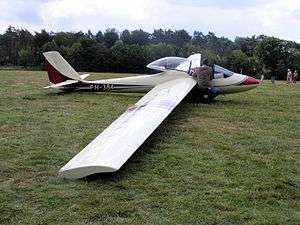N.V. Vliegtuigbouw 013 Sagitta
| 013 Sagitta | |
|---|---|
 | |
| Role | Standard-class sailplane |
| National origin | Netherlands |
| Manufacturer | N.V. Vliegtuigbouw |
| Designer | Piet Alsema |
| First flight | 4 July 1960[1] |
| Status | Production completed |
| Number built | 20 |
The N.V. Vliegtuigbouw 013 Sagitta (English: Arrow) is a Dutch mid-wing, single-seat Standard Class glider designed by Piet Alsema and produced by N.V. Vliegtuigbouw.[2][3][4][5]
The aircraft is reported by different sources under a variety of different names and designations. Sources label it the Alsema Sagitta, Vliegtuigbouw Sagitta, N.V. Vliegtuigbouw 013 Sagitta, Dutch Sagitta, N.V. Vliegtuigbouw Sagitta 013 and N.V. Vliegtuigbouw Sagitta-013. The US type certificate erroneously lists it as the N.V. VLIEGTUIGBOUW Segitta (sic) 013 and catalogs it in their database under Vilegtuigbouw (sic), N.V., 013.[2][3][4][5]
Design and development
The Sagitta was designed by Alsema between 1957-61 specifically for the then-new FAI Standard Class. Like other early standard class gliders it was quickly surpassed in performance by newer fibreglass aircraft.[2][3]
The Sagitta has a wooden structure. The fuselage is covered with plywood, the wings and tail surfaces with plywood and doped aircraft fabric covering. The 15.0 m (49.2 ft) span wing features top and bottom air brakes and employs [NACA]] 63-618 airfoil at the wing root, and a NACA 4412 section at the wing tip. The controls are automatically connected on assembly. The bubble canopy slides aft for cockpit access and can be locked open in several positions in flight. The landing gear is a fixed monowheel.[2][3][6]
In the Netherlands the aircraft was certified for cloud flying and aerobatics, but its US certification does not include these authorizations. The type received its US type certificate on 2 August 1965.[2][3][4]
Twenty Sagittas were built.[2][3]
Operational history
In July 2011 six Sagittas were still registered with the US Federal Aviation Administration.[5]
Variants
- Sagitta
- Prototype first flown on 4 July 1960.[7]
- Sagitta 2
- [7]FAI Standard Class model with 15.0 m (49.2 ft) wingspan.[2][3]
- Super Sagitta
- FAI Open Class model with 17.0 m (55.8 ft) wingspan[8]
Aircraft on display
Specifications (Sagitta)
Data from Sailplane Directory, Soaring and FAA type certificate G7eu[2][3][4] The World's Sailplanes:Die Segelflugzeuge der Welt:Les Planeurs du Monde Volume II[1]
General characteristics
- Crew: one
- Length: 6.465 m (21 ft 3 in)
- Wingspan: 15.0 m (49 ft 3 in)
- Wing area: 12.000 m2 (129.17 sq ft)
- Aspect ratio: 18.7:1
- Airfoil: Root: NACA 633618, tip: NACA 4412
- Empty weight: 217 kg (478 lb)
- Gross weight: 320 kg (705 lb)
Performance
- Stall speed: 66 km/h (41 mph; 36 kn)
- Never exceed speed: 270 km/h (168 mph; 146 kn)
- Rough air speed max: 200 km/h (124.3 mph; 108.0 kn)
- Aerotow speed: 140 km/h (87.0 mph; 75.6 kn)
- Winch launch speed: 120 km/h (74.6 mph; 64.8 kn)
- Terminal velocity: with full airbrakes 220 km/h (137 mph; 119 kn)
- g limits: +8 -5.5 at 270 km/h (167.8 mph; 145.8 kn)
- Maximum glide ratio: 34:1 at 97 km/h (60.3 mph; 52.4 kn)
- Rate of sink: 0.64 m/s (126 ft/min) at 78 km/h (48.5 mph; 42.1 kn)
- Wing loading: 26.7 kg/m2 (5.5 lb/sq ft)
See also
- Aircraft of comparable role, configuration and era
- Related lists
Notes
- 1 2 Shenstone, B.S.; K.G. Wilkinson (1963). The World's Sailplanes:Die Segelflugzeuge der Welt:Les Planeurs du Monde Volume II (in English, French, and German) (1st ed.). Zurich: Organisation Scientifique et Technique Internationale du Vol a Voile (OSTIV) and Schweizer Aero-Revue. pp. 34–36.
- 1 2 3 4 5 6 7 8 Activate Media (2006). "Sagitta Vliegtuigbouw". Retrieved 20 July 2011.
- 1 2 3 4 5 6 7 8 Said, Bob: 1983 Sailplane Directory, Soaring Magazine, page 96, Soaring Society of America November 1983. USPS 499-920
- 1 2 3 4 Federal Aviation Administration (August 1965). "Type Certificate Data Sheet No. G7EU" (PDF). Retrieved 20 July 2011.
- 1 2 3 Federal Aviation Administration (July 2011). "Make / Model Inquiry Results". Retrieved 20 July 2011.
- ↑ Lednicer, David (2010). "The Incomplete Guide to Airfoil Usage". Retrieved 1 July 2011.
- 1 2 Taylor, John W.R. FRHistS. ARAeS (1962). Jane's All the World's Aircraft 1962-63. London: Sampson, Low, Marston & Co Ltd.
- ↑ Rogers, Bennett: 1974 Sailplane Directory, Soaring Magazine, page709. Soaring Society of America, August 1974. USPS 499-920
- ↑ Aviodrome (n.d.). "Collectiestuk a-f.pdf" (PDF). Retrieved 20 July 2011.
References
- Shenstone, B.S.; K.G. Wilkinson (1963). The World's Sailplanes:Die Segelflugzeuge der Welt:Les Planeurs du Monde Volume II (in English, French, and German) (1st ed.). Zurich: Organisation Scientifique et Technique Internationale du Vol a Voile (OSTIV) and Schweizer Aero-Revue. pp. 34–36.
- Taylor, John W.R. FRHistS. ARAeS (1962). Jane's All the World's Aircraft 1962-63. London: Sampson, Low, Marston & Co Ltd.
External links
| Wikimedia Commons has media related to N.V. Vliegtuigbouw. |